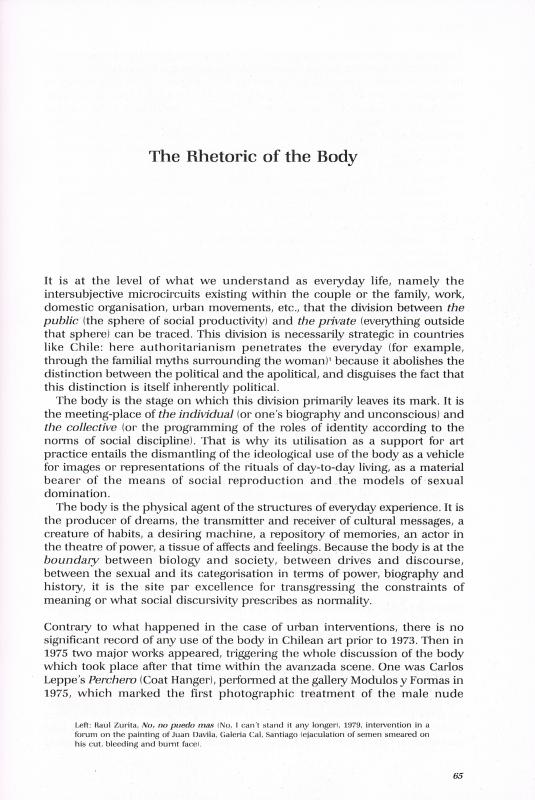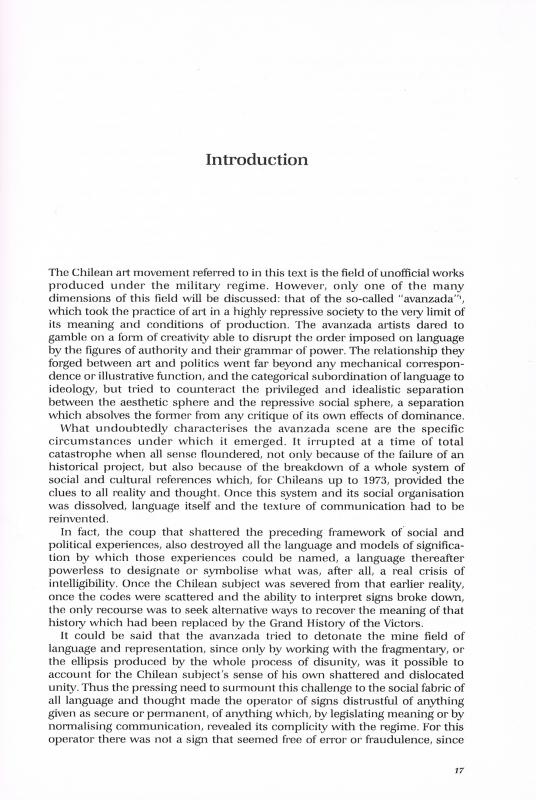“Una mirada sobre el arte en Chile” (An Overview of Art in Chile) is a (self-published) work by the theorist and cultural critic Nelly Richard (b. 1948), published in 1981, in which she used the concept of Escena de Avanzada for the first time. It includes the original notes that would become her book Margins and Institutions. Art in Chile Since 1973, published in Australia in 1986. In this book, Richard presents a broad overview of Chilean art in terms of the problems that underpin a “multi-dimensional history.” The nine chapters are: “Ellipsis and Metaphor”; “The Photographic Condition”; “The Scene of Writing”; “The Dimension of Social Exteriority in the Production of Art”; “Return to the Pleasurable,” see the ICAA Digital Archive (doc. no. 743686); “The Displacement of Supports and the Eradication of the Boundaries between Genres”; “The Problematic of Latin American Art”; “History and Memories”; and “Rhetoric of the body,” see (doc. no. 744815). The introduction to the book (doc. no. 738523) provides a broad outline of what the Avanzada (“advanced scene”) is about.
Escena de Avanzada was an umbrella term for neo-avant-garde practices that challenged art and the ways in which art was produced in a country under the rule of a civilian-military dictatorship (1973–90) where every aspect of social life had been dismantled. The scene involved the production of an unofficial kind of art designed to stimulate critical awareness and a resistance to the imposition of the government’s strategies for political repression. These art practices prioritized the use of language in an attempt to challenge the dominant cultural discourse. Richard’s work prompted a discussion about art, politics, and society from a range of different points of view. It is hard to say, specifically, who was part of the Escena de Avanzada, because Richard mentions several artists in her book, but does not review their work uniformly. For example, she developed theoretical and emotional bonds with Carlos Altamirano (b. 1954), Carlos Leppe (1952–2015), Juan Domingo Dávila (b. 1946), and their works. This led to projects such as the Galería Cromo with Leppe and Altamirano (1977), the publication of her books Cuerpo correccional (Correctional Body, 1980, with Leppe), and the La cita amorosa (Love in Quotes, 1985), with Dávila, who was also instrumental in the publication of Margins and Institutions (in a special edition of the international art magazine Art and Text (Melbourne/New York), since Richard had moved to Australia in 1974 after the coup d’état in Chile. Dávila also contributed to the catalogues for all their exhibitions (in the 1970s and 1980s).



